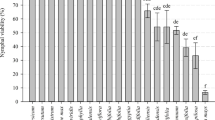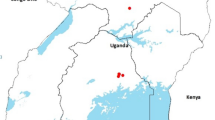Abstract
Bemisia tabaci (Gennadius) biotype B, called a “superbug”, is one of the most harmful biotypes of this species complex worldwide. In this report, the invasive mechanism and management of B. tabaci biotype B, based on our 5-year studies, are presented. Six B. tabaci biotypes, B, Q, ZHJ1, ZHJ2, ZHJ3 and FJ1, have been identified in China. Biotype B dominates the other biotypes in many regions of the country. Genetic diversity in biotype B might be induced by host plant, geographical conditions, and/or insecticidal application. The activities of CarE (carboxylesterase) and GSTs (glutathione-S-transferase) in biotype B reared on cucumber and squash were greater than on other host plants, which might have increased its resistance to insecticides. The higher activities of detoxification enzymes in biotype B might be induced by the secondary metabolites in host plants. Higher adaptive ability of biotype B adults to adverse conditions might be linked to the expression of heat shock protein genes. The indigenous B. tabaci biotypes were displaced by the biotype B within 225 d. The asymmetric mating interactions and mutualism between biotype B and begomoviruses via its host plants speed up widespread invasion and displacement of other biotypes. B. tabaci biotype B displaced Trialeurodes vaporariorum (Westwood) after 4–7 generations under glasshouse conditions. Greater adaptive ability of the biotype B to adverse conditions and its rapid population increase might be the reasons of its successful displacement of T. vaporariorum. Greater ability of the biotype B to switch to different host plants may enrich its host plants, which might enable it to better compete with T. vaporariorum. Native predatory natural enemies possess greater ability to suppress B. tabaci under field conditions. The kairomones in the 3rd and 4th instars of biotype B may provide an important stimulus in host searching and location by its parasitoids. The present results provide useful information in explaining the mechanisms of genetic diversity, evolution and molecular eco-adaptation of biotype B. Furthermore, it provides a base for sustainable management of B. tabaci using biological and ecological measures.
Similar content being viewed by others
References
Brown J K. The sweet potato or silverleaf whiteflies: Biotypes of Bemisia tabaci or a species complex. Ann Rev Entomol, 1995, 40: 511–534 10.1146/annurev.en.40.010195.002455, 1:CAS:528:DyaK2MXjtVWlt7g%3D
Oliveira M R V, Henneberry T J, Anderson P. History, current status, and collaborative research projects for Bemisia tabaci. Crop Protect, 2001, 20: 709–723 10.1016/S0261-2194(01)00108-9
Bedford I D, Briddon R W, Brown J K, et al. Geminivirus transmission and biological characterization of Bemisia tabaci (Gennadius) biotypes from different geographic regions. Ann Appl Biol, 1994, 125: 311–325 10.1111/j.1744-7348.1994.tb04972.x
Schuster D J, Mueller T F, Kring J B, et al. Relationship of the sweetpotato whitefly to a new tomato fruit disorder in Florida. Hort Sci, 1990, 25: 1618–1620
Segarra-Carmona A E, Bird J, Escudero J. Silvering of Cucurbita moschata (Duchesne Poir) associated with Bemisia tabaci Genn. (Homoptera: Aleyrodidae) in Puerto Rico. J Agr Univ Puerto Rico, 1990, 74: 477–478
Yokomi R K, Hoelmer K A, Osborne L S. Relationship between the sweetpotato whitefly and the squash silverleaf disorder. Phytopathology, 1990, 80: 895–900 10.1094/Phyto-80-895
Perring T M. The Bemisia tabaci species complex. Crop Protect, 2001, 20: 725–737 10.1016/S0261-2194(01)00109-0
Simon B, Cenis J L, Demichelis S, et al. Survey of Bemisia tabaci (Hemiptera: Aleyrodidae) biotypes in Italy with the description of a new biotype (T) from Euphorbia characias. Bul Entomol Res, 2003, 93: 259–264 1:STN:280:DC%2BD3s3ktV2qtg%3D%3D
Delatte H, Reynaud B, Granier M, et al. A new silverleaf-inducing biotype Ms of Bemisia tabaci (Hemiptera: Aleyrodidae) indigenous to the islands of the south-west Indian Ocean. Bul Entomol Res, 2005, 95: 29–35 1:STN:280:DC%2BD2M%2FpsVSntA%3D%3D
Luo C, Yao Y, Wang R J, et al. The use of mitochondrial cytochrome oxidase I (mtCO I) gene sequences for the identification of biotypes of Bemisia tabaci (Gennadius) in China. Acta Entomol Sinica, 2002, 45: 759–763 1:CAS:528:DC%2BD2cXisFOjtL8%3D
Barinaga M. Is devastating whitefly invader really a new species? Science, 1993, 259: 30 8418492, 10.1126/science.8418492, 1:STN:280:DyaK3s7hslynug%3D%3D
Zhang Z L. Some thoughts to the outbreaks of tobacco whitefly. Beijing Agri Sci, 2000, (suppl, Bemisia specific): 1–3
Luo C, Zhang J M, Shi B C, et al. Investigation of Bemisia tabaci (Gennadius) in Beijing area. Beijing Agri Sci, 2000, (suppl, Bemisia specific): 42–47
Shi B C, Luo C, Zhang J M, et al. Toxicities of 12 insecticides to Bemisia tabaci (Gennadius) in fields. Beijing Agri Sci, 2000, (suppl, Bemisia specific): 48–54
Luo C, Wang S Q, Zhang Z L. Population dynamics of whiteflies and natural enemies in the suburbs of Beijing. In: Contemporary Entomology Research, Proceedings of Entomology Society of China for Establishment 60 years, cum Academic Conference, 2004, Beijing, China. 465–468
Zang L S, Liu S S, Liu Y Q, et al. Competition between the B biotype and a non-B biotype of the whitefly, Bemisia tabaci (Homoptera: Aleyrodidae) in Zhejiang, China. Biodivers Sci, 2005, 13(3): 181–187 10.1360/biodiv.040202, 1:CAS:528:DC%2BD28Xjt1Orur4%3D
Chu D, Zhang Y J, Cong B, et al. Sequence analysis of mtDNA COI gene and molecular phylogeny of different geographical populations of Bemisia tabaci (Gennadius). Sci Agri Sin, 2006, 38: 76–85
Chu D, Zhang Y J, Brown J K, et al. The introduction of the exotic Q biotype of Bemisia tabaci from the Mediterranean region into China on ornamental crops. Florida Entomol, 2006, 89(2): 168–174 10.1653/0015-4040(2006)89[168:TIOTEQ]2.0.CO;2
Li Z X. Molecular phylogenetic analysis reveals at least five genetic races of Bemisia tabaci in China. Phytoparasitica, 2006, 34(5): 431–440 10.1007/BF02981197, 1:CAS:528:DC%2BD28Xht1Cnu7bI
Xu Q, Wang W L, Liu S S. Occurrence of Q biotype Bemisia tabaci in some areas of Zhejing. Plant Prot, 2006, 32(4): 121
Jiu M, Zhou X P, Liu S S. Transmission of geminiviruses by whitefly. Acta Entomol Sin, 2006, 49: 513–520
Jiu M, Zhou X P, Liu S S. Acquisition and transmission of Tobacco curly shoot virus by the B biotype of the whitefly, Bemisia tabaci. Acta Phytophys Sin, 2006, 33(2): 168–172
Jiu M, Zhou X P, Tong L, et al. Vector-virus mutualism accelerates population increase of an invasive whitefly. PLoS ONE, 2007, 2(1): e182 17264884, 10.1371/journal.pone.0000182
Zhang L P. Studies on population dynamics, genetic diversity of invasive Bemisia tabaci and its molecular mechanism of resistance to thiamethoxam. PhD Dissertation. Beijing: China Agri Univ, 2005
Zhang L P, Zhang Y J, Zhang W J, et al. Analysis of genetic diversity among different geographical populations and determination of biotypes of Bemisia tataci in China. J Appl Entomol, 2005, 129(3): 121–128 10.1111/j.1439-0418.2005.00950.x, 1:CAS:528:DC%2BD2MXksVygtrw%3D
Chu D, Liu G X, Fan Z X, et al. Genetic differentiation of different geographical populations of Bemisia tabaci (Gennadius) complex. Acta Entomol Sin, 2006, 49: 687–694 1:CAS:528:DC%2BD2sXhtlChs7%2FE
Zang L S, Fu R X, Liu S S, et al. Comparison of susceptibility to insecticides between the B biotype and a non-B biotype of Bemisia tabaci in Zhejiang. Entomol Knowl, 2006, 43(2): 207–210 1:CAS:528:DC%2BD2sXmsVGisLg%3D
Chu D, Wan F H, Xiao L F, et al. The effects of hiamethoxam on Bemisia tabaci biotype B population genetic. Acta Entomol Sin, 2008, 51: 150–154
Liang P, Cui J Z, Yang X Q, et al. Effects of host plants on insecticide susceptibility and carboxylesterase activity in Bemisia tabaci biotype B and greenhouse whitefly, Trialeurodes vaporariorum. Pest Manage Sci, 2007, 63: 365–371 10.1002/ps.1346, 1:CAS:528:DC%2BD2sXksF2ltro%3D
Mao S F, Liang P, Gao X Y. Effects of quercetin on specific activity of carboxylesterase and glutathione S-transferases in Bemisia tabaci. Entomol Knowl, 2006, 43(4): 491–495
Wang H H. Molecular cloning and bacterial expression of heat shock proteins and their relationship with stress tolerance in Bemisia tabaci (B biotype). PhD Dissertation. Beijing: Institute of Plant Protection, Chinese Academy of Agricultural Sciences, 2005
Cui X H. Adaptation of two whitefly species, Bemisia tabaci (Gennadius) B-biotype and Trialeurodes vaporariorum (Westwood) (Homoptera: Aleyrodidae), to thermal stress: Temperature responses and molecular mechanisms. Institute of Plant Protection. PhD Dissertation. Beijing: Chinese Academy of Agricultural Sciences, 2007
Liu S S, De Barro P J, Xu J, et al. Asymmetric mating interactions drive widespread invasion and displacement in a whitefly. Science, 2007, 318: 1769–177 17991828, 10.1126/science.1149887, 1:CAS:528:DC%2BD2sXhsVWhu7bO
Luo C, Guo X J, Yue M, et al. Host plant effects on the morphological and biological characteristics of Bemisia tabaci (Gennadius) biotype B. Biodivers Sci, 2006, 14(4): 333–339 10.1360/biodiv.050276
Gao Q G, Luo C, Guo X J, et al. EPG-recorded probing and feeding behaviors of Bemisia tabaci and Trialeurodes vaporariorum on cabbage. Entomol Knowl, 2006, 43(6): 802–805
Cui X H, Wan F H, Xie M, et al. Effects of heat shock on survival and fecundity of two whitefly species: Trialeurodes vaporariorum and Bemisia tabaci B biotype (Homoptera: Aleyrodidae). J Insect Sci, 2008, 1: 1–10 10.1673/031.008.2401
Cui X H, Xie M, Wan F H. Temperature on survival and fecundity of two whitefly species: Bemisia tabaci B-biotype and Trialeurodes vaporariorum (Homoptera: Aleyrodidae). Sci Agri Sin, 2008, 41(1): 424–430
Cui X H, Xie M, Wan F H. Survival characteristics of Bemisia tabaci B-biotype and Trialeurodes vaporariorum (Homoptera: Aleyrodidae) after exposure to adverse temperature conditions. Acta Entomol Sin, 2008, 51: 1232–1238
Chen Y H, Cui X H, Xie M, et al. Growth and reproduce characteristics of Bemisia tabaci B-biotype and Trialeurodes vaporariorum (Homoptera: Aleyrodidae) after exposure to low temperature conditions. Chin J Eco-Agri, 2008, 16(6): in press
Lei F, Zhang G F, Wan F H, et al. Effects of plant species switching on contents and dynamics of trehalose and trehalase activity of Bemisia tabaci B-biotype and Trialeurodes vaporariorum. Sci Agri Sin, 2006, 39: 1387–1394 1:CAS:528:DC%2BD2sXlslersb0%3D
Zang L S, Chen W Q, Liu S S. Comparison of performance on different host plants between the B biotype and a non-B biotype of Bemisia tabaci from Zhejiang, China. Entomol Exp Appl, 2006, 121: 221–227 10.1111/j.1570-8703.2006.00482.x
Elton C S. The Ecology of Invasion by Animals and Plants. London: Methuen and Co. Ltd, 1958
Lü Z C, Zhang G F, Wan F H, et al. Detection of predation on Bemisia tabaci by using SCAR markers. Sci Agri Sin, 2005, 38: 1167–1173
Zhang G F, Lü Z C, Wan F H. Detection of Bemisia tabaci remains in predator guts using a sequence-characterized amplified region marker. Entomol Exp Appl, 2007, 123(1): 81–90 10.1111/j.1570-7458.2007.00528.x, 1:CAS:528:DC%2BD2sXlt1Krt78%3D
Zhang G F, Lü Z C, Wan F H, et al. Real-time PCR quantification of Bemisia tabaci (Homoptera: Aleyrodidae) remains in predator guts. Mol Ecol Note, 2007, 7: 947–954 10.1111/j.1471-8286.2007.01819.x, 1:CAS:528:DC%2BD1cXls12ltw%3D%3D
Nomikou M, Meng R X, Schraag R, et al. How predatory mites find plants with whitefly prey. Exp Appl Acarol, 2005, 36: 263–275 16132740, 10.1007/s10493-005-6650-0
Meng R X, A Janssen, M Nomikou, et al. Previous and present diets of mite predators affect antipredator behaviour of whitefly prey. Exp Appl Acarol, 2006, 38: 113–124 16596346, 10.1007/s10493-006-0010-6
Liu W X, Yang Y, Wan F H, et al. Comparative analysis of carbohydrates, amino acids and volatile components of honeydew produced by two whiteflies Bemisia tabaci B-biotype and Trialeurodes vaporariorum (Homoptera: Aleyrodidae) feeding cabbage and cucumber. Acta Entomol Sin, 2007, 50: 850–857 1:CAS:528:DC%2BD2sXhsVart7jN
Liu W X, Yang Y, Wan F H, et al. Behaviour responses of Encarsia formosa Gahan for Bemisia tabaci B-biotype adverse development stages. Chin J Biol Contr, 2008, 24(2): 97–102 10.1016/j.biocontrol.2008.06.007, 1:CAS:528:DC%2BD1cXhtFant7bM
Liu T X, Oetting R D, Buntin G D. Evidence of interspecific competition between Trialeurodes vaporariorum (Westwood) and Bemisia tabaci (Gennadius) (Homoptera: Aleyrodidae) on some greenhouse-grown plants. J Entomol Sci, 1994, 29: 55–65
Author information
Authors and Affiliations
Corresponding author
Additional information
Supported by the National Basic Research and Development Program of China (973 Program) of China (Grant No. 2009CB119200)
Rights and permissions
About this article
Cite this article
Wan, F., Zhang, G., Liu, S. et al. Invasive mechanism and management strategy of Bemisia tabaci (Gennadius) biotype B: Progress report of 973 Program on invasive alien species in China. SCI CHINA SER C 52, 88–95 (2009). https://doi.org/10.1007/s11427-008-0135-4
Received:
Accepted:
Published:
Issue Date:
DOI: https://doi.org/10.1007/s11427-008-0135-4




